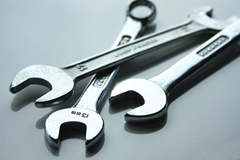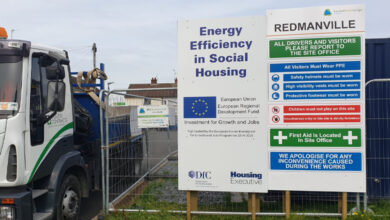Programme for Government update
 agendaNi reviews the Executive’s progress against targets on education, skills and training.
agendaNi reviews the Executive’s progress against targets on education, skills and training.
Apprenticeships, GCSE results and further education enrolments are the main successful areas for skills under the Programme for Government. However, delayed government strategies and a falling number of young people in education and training are two of the major negatives.
agendaNi asked the Department for Employment and Learning (DEL) and Department of Education for statistics on their progress against targets in the programme.
Hits
Staff and students in further education and training (DEL’s remit) can claim a number of successes.
All component projects listed in the Success through Skills strategy have been launched. That strategy was reviewed ahead of schedule in 2008 (the target was 2009). A revised strategy went out for public consultation in June 2010 and the final version is waiting for Executive approval.
Essential Skills courses have proved successful with 49,258 learners gaining a qualification by 30 November 2010, exceeding the 42,000 by March 2011 target by 17 per cent.
The percentage of apprenticeships fully completed to level 3 reached 51 per cent in 2009-2010, compared to a 44 per cent target.
Further education enrolment targets have been mostly been reached, as the following table shows:
| 2005-2006 baseline | 2010-2011 target | 2010-2011 result | |
| Level 2 | 29 | 32 | 28.3 |
| Level 3 | 57 | 60 | 62.5 |
| Professional and technical courses | 82 | 90 | 90.9 |
| NQF* courses | 91 | 95 | 96.7 |
Misses
Regional employment and skills action plans were to be developed by March 2009. Six action plans have been drawn up by workforce development forums; it is up to each forum whether these are published. Three others, developed by sector-specific groups, have been published and cover ICT (June 2008), hospitality and tourism (November 2009) and financial services (December 2010). DEL claimed the last one’s long delay was “due to the global crisis in the financial services markets.”
Level 2 enrolments for further education have fallen: 28.3 per cent in 2010-2011, compared to 29 per cent in 2005-2006. The target was 32 per cent in 2010-2011.
While disappointed with the level 2 figures, DEL adds that over 3,300 people commenced a programme-led apprenticeship in 2009-2010.
A new careers strategy was due to be launched by June 2008 but was not published until January 2009. According to DEL, its “complexity and cross-cutting nature” caused a delay and progress has been made. This was drawn up jointly with the Department of Education.
The two departments were also tasked with drawing up a strategy on STEM skills shortages by 2011. The relevant consultation ended in November 2010, meaning that the final version was late; it will be “published shortly” after being approved by the Executive.
Separately, the level of support from further education colleges to employers would be measured, with baselines set up by December 2008. However, this was only done in June 2010.
A second commitment was to achieve a 10 per cent improvement in knowledge transfer by 2010-2011, measured by key indicators e.g. income generated by universities from research and consultancy. The report is not yet available. All sector skills agreements were to be in place by December 2008; the last was published in January 2009.
Not yet
It is too early to tell whether some targets will be reached. By 2015, for example, the Executive wants 80 per cent of the working age population qualified to skill level 2 and 60 per cent to level 3.
In July-September 2010, 67.9 per cent were qualified to level 2, up from 66.7 per cent in the previous quarter. The level 3 statistic was 50.5 per cent, up from 49.5 per cent.
The working age population qualified to level 2 and living in neighbourhood renewal areas was also due to increase by 2015. The 2009 figure was 44.8 per cent and 2010 figures will be published this August.
As of 2005-2006, 22 per cent of further education enrolments came from ‘more deprived regions’ of Northern Ireland; these are identified by using NISRA’s multiple deprivation measures. The target is 24 per cent by 2010-2011 and the previous year’s percentage stood at 23. DEL points out that the number of students from the most deprived regions has increased by almost 10,000.
Six “priority skill areas” for Northern Ireland were identified back in 1999: construction; ICT; manufacturing engineering; software engineering; hospitality and tourism; and electronics.
Twenty-five per cent of all FE enrolments were for these courses in 2005-2006. A target of 28 per cent was set for 2010- 2011. However, by 2009-2010, the proportion had dropped to 23.5 per cent. Construction courses have been particularly badly hit by the downturn, with year-on-year decreases since 2007.
These figures do not record programme- led apprenticeships, which are “contributing significantly”. For example, in February 2011, 92 per cent of the 2,805 apprentices were learning some kind of priority skill.
DEL also pledged to make year-on-year progress on fair access to higher education; a slight improvement has occurred. In 2008-2009, 25.8 per cent of first year full-time undergraduates were from socio-economic groups five to seven, compared to 24.5 per cent in 2006-2007.
Schools
The Department of Education was asked for an update on its commitments but said this was “not yet available in the public domain”. agendaNi’s own research found much of the information on the department’s statistics and research pages.
On the positive side, all children can now pick up entrepreneurial skills through the Learning for Life and Work programme, as had been envisaged. Three GCSEs targets for 2011 have already been surpassed:
Among students entitled to free school meals, 30 per cent should reach level 2 English and maths; that figure was almost reached in 2008-2009 (at 29.7 per cent).
One major disappointment was the falling participation rate, for 16-17 year olds in full-time education or vocational training. This was 89.9 per cent in 2006-2007 but has fallen year-on-year since then due to the downturn. The 2008-2010 level was 86.1 per cent and the aim was 95 per cent by 2011.
No statistics were found for increasing attainment in neighbourhood renewal areas, STEM subjects studied by post-16 pupils, or A-level students gaining three or more A-C grades; the latter target is 65 per cent by 2011.
GCSE results (%)
| Indicator | 2009 Result | 2011 target |
| Five A*- C | 70.1 | 68 |
| Five A*- C (including English and maths) | 58.3 | 55 |
| A*- G (including English and maths) | 88.2 | 90 |





